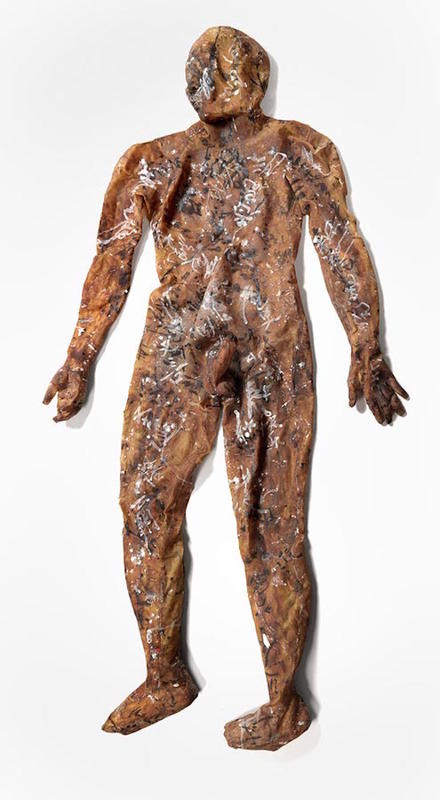More about Rubber Man

Contributor
Why yes, that is a rubber cast of Pan Xing Lei’s, ahem, *entire* body.
It probably wasn’t so comfortable for the artist to cast himself to create this sculptural work (well, technically it’s a piece of performance ephemera, but now it exists as a sculpture - semantics, you know). It is a polyurethane cast of the artist’s body, painted with messy Chinese characters, and stuffed with paper in the hands, head, and feet (and luckily nowhere else).
Now, I am giving the impression that this is a rather dirty work. In fact, this is one of many of the artist’s bodily casts, that are actually inspired by the 1989 Tiananmen Square protests. The artist was one of six who installed The Goddess of Democracy monument that day, before governmentally-sanctioned tanks attacked the gathered crowd. Pan Xing Lei was just 19 at the time, and the image of those bodies stayed with him - inspiring his performance and sculptural works since.
This particular rubber man is one iteration of many. In addition to rubber, Pan Xing Lei has also made these figures out of such materials as plastic, fiberglass, and bronze - playing with the hardness, softness and malleability of the human body. Rubbermen have appeared in video works, as solitary sculptures (like this one at SCMA), or in performances - such as one 2001 instance of Pan Xing Lei seated like Buddah amongst multiple rubbermen that were hung up on walls or crumpled on the floor.
Perhaps what makes this particular Rubber Man special is the collection in which it lives. The Smith College Museum of Art has immense depth in its collection of Asian art. In 1913, Charles Lang Freer (yes, the man who gave the Smithsonian Freer Gallery its name) gave SCMA 45 works of art from across Asia. Almost 100 years later, Rubber Man was given to the museum in the same spirit.
Here is the question I’m left with: how does Pan Xing Lei have the patience to cast his entire body?! I’d be busting out of there faster than you can say rubber woman.
Sources
- “Being Charged with Criminal Damage at Court, 'Red Man' Pan Xing Lei Released on $10,000 Bail, 被控刑事毀壞罪提堂 「紅人」潘星磊萬元保釋.” Asia Art Archive. Accessed 2 July 2019, https://aaa.org.hk/en/collection/search/archive/ha-bik-chuen-archive/ar…
- “Bodies in Transformation.” Smith College Museum of Art, accessed 4 July 2019, https://www.smith.edu/artmuseum/On-View/Past-Exhibitions/Modern-Images-….
- Chen, Shieh-Wen. “When Art Clashes in the Public Sphere—Pan Xing Lei’s Strike of Freedom Knocking on the Door of Democracy in Hong Kong.” Yishu, December 2005, accessed July 2, 2019, http://yishu-online.com/browse-articles/?280.
- Heartney, Eleanor. “From the Archives: Children of Mao and Coca-Cola.” Art in America. 1 March 1999, accessed 2 July 2019, https://www.artinamericamagazine.com/news-features/magazines/from-the-a….
- Mingliu, Gao (editor). Inside Out: New Chinese Art. Published by SFMoMA and Asia Society, NYC. Pages 178-9. Accessed 2 July 2019 from https://books.google.com/books?id=8GwzF6mFBBAC&pg=PA178&lpg=PA178&dq=pa…
- Morano, Rob. “Tiananmen Square Sculptor Returns VCU Salute.” Style Weekly, accessed 4 July 2019, https://www.styleweekly.com/richmond/a-lifesaving-brother-sister-duo-ma…
- “New Music at Bowling Green.” 2004, accessed 2 July 2019, http://www-personal.umich.edu/~cyoungk/bgsu03.htm.
- “Newsletter: East Asian Art and Archaeology, Issues 57-70.” accessed 2 July 2019, https://books.google.com/books?id=37mfAAAAMAAJ&pg=RA10-PA8&lpg=RA10-PA8…
- “Pan Xing Lei.” artsy, accessed July 2, 2019, https://www.artsy.net/artist/pan-xing-lei.
- “Pan Xing Lei.” Eazel.net, accessed 2 July 2019, https://eazel.net/artists/284.
- “Pan Xing Lei.” hawaii.edu/artgallery, accessed 2 July 2019, http://hawaii.edu/artgallery/shoebox/8/artists/pages/Pan.html.
- Pan Xing Lei: Biography.” artnet, accessed 2 July 2019, http://www.artnet.com/artists/pan-xing-lei/biography.
- “Pan Xing Lei: Biography.” MutualArt, accessed 2 July 2019, https://www.mutualart.com/Artist/Pan-Xing-Lei/86007A3AA599775A/Biography.
- “Pan Xing-lei | Imitating the Bei Wei Buddha” CrossPathCulture, accessed 2 July 2019, http://www.crosspathculture.org/panxinglei/pxl_04.html.
- “Pan Xing Lei: Intervention.” ArtLinkArt, accessed 2 July 2019. http://www.artlinkart.com/en/artist/exh_yr/afahrvr.
- “Pan Xing Lei: Rubber Man.” 5 Colleges Collection Database, accessed 4 July 2019, http://museums.fivecolleges.edu/detail.php?museum=sc&t=objects&type=all….
- “SKIN: New Work of Artist Pan Xing Lei.” Absolute Arts, 2011, accessed 2 July 2019, https://www.absolutearts.com/artsnews/2001/05/17/28567.html.
- Smee, Sebastian. “Showcasing a continent’s art at Smith College.” The Boston Globe, 4 May 2013, accessed 4 July 2019, http://www.trfineart.com/wp-content/uploads/2016/10/Boston-globe-smith-….
- “The Fuck-Off Generation at Ethan Cohen.” ArtLinkArt, accessed 2 July 2019, http://www.artlinkart.com/en/artist/exh_yr/afahrvr/2f8fACli.











